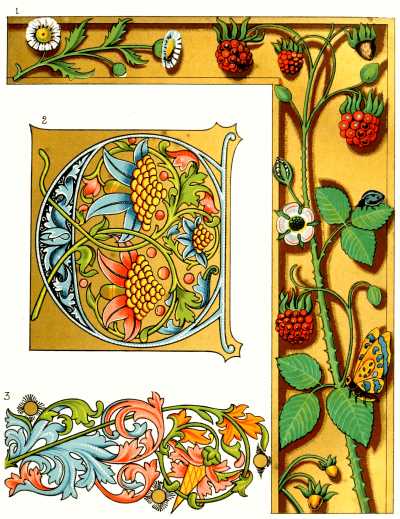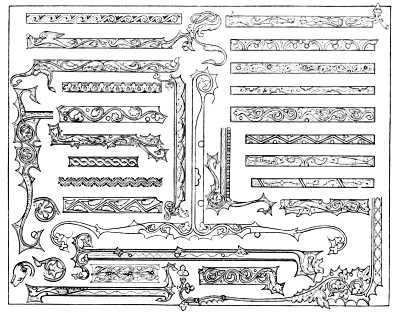

Left: Plate V. Ornaments and Large Initial, 15th and 16th Centuries. Right: Bands and Border Ornaments, Fourteenth Century from Lessons in the Art of Illuminating by W. J. Loftie. Source: Project Gutenberg EBook #40423 produced by Chris Curnow, Matthew Wheaton and the Online Distributed Proofreading Team. [Click on images to enlarge them.]
Description of Plate V
Plate V. shows three ornaments from manuscripts of late date, all in the National Collections.
The border with the raspberries is from a Missal of the sixteenth century in the British Museum (Addl. 18,855), and was probably written and illuminated in the Low Countries. We have already mentioned the extraordinary freedom and ease of the Flemish work of that period. Every beautiful object was made use of for pictorial effect. Children, birds, jewels, shells, as well as fruit and flowers, are to be found. They particularly excelled in painting pearls. One border is green, with chains and ropes of pearls strewn all over it. The calendar represents domestic scenes, each strongly surrounded with a double gold line, the written part being simply left out in the middle, so that the scene forms its border. The gold ground presents a slightly different appearance from that shown in our engraving, as it is flat, being painted with shell-gold not put on very thickly. The shadows are of Burnt Umber, which has a very transparent effect on the gold ground.
Beside this border is a fine letter of somewhat earlier date from a chorale book, German work in all probability, which, with many others, Italian and Flemish as well as German, were ruthlessly cut up into fragments, perhaps at the Reformation, perhaps more recently, and are now in the Art Library of the South Kensington Museum. They are much rubbed and faded, and our chromo-lithograph represents this initial C as it appeared when first finished. In much of the northern work of this period—about the middle of the fifteenth century, say 1450—there is a beautiful style of ornamental scroll-work, which some have proposed to call the "Leather Pattern." It may represent the cut leather work of the mantling of a knight's tilting helmet. A small specimen of it is shown in the turned-back petals of the flowers in this letter, but whole volumes are to be seen entirely decorated with it, and some of the best work of the period was accomplished in it.
The third of these ornaments is also from the collection in the South Kensington Museum. In this design the thing to be most noticed is perhaps that which is least prominent, namely, the gold spots, with black filaments, as it were, floating from them. They serve to eke out and fill up the composition, and in some books are used with fine effect on almost every page. They should be thickly gilt on a raised surface, and should have dark outlines, and the filaments rapidly and lightly drawn, either with a pen or with a very fine brush, pruned down almost to a single hair. Many other pretty effects may be obtained by early training the hand and eye to draw single lines in this way. The letters in one of our other Plates (No. I.) are entirely filled with tracery of the kind, and the patterns principally in use are easily learned. Anything free is preferable to servile imitation and tracing, and these diapers in particular lose more than almost anything else in the whole art of illumination by direct copying. The student should learn to adapt his delicate lines—chiefly in red and blue—to any form of letter, and while drawing them should not let his hand falter or hesitate for a moment. It is the same with the lace-like patterns in white which were so much in vogue for heightening the edges of letters in the thirteenth and fourteenth centuries. They are very necessary to the effect, but must be painted in with a light touch and great rapidity, or they lose all spirit.
The initial P on the previous page, and also the initials in pages vii. and 1, have been taken from MSS. illuminated with the "English flower-pattern." An attempt has been made to represent the colors employed by means of lines. This system was first applied to heraldry in the first half of the seventeenth century. Horizontal lines represent blue; vertical, red; cross hatching, black; dotting, gold or yellow. Green is denoted by lines "in bend dexter," and purple by lines "in bend sinister."
The bands and borders on the back of Plate V. are of the fourteenth century, but similar ornaments were common at all times. They are chiefly red or blue, with patterns in white lines and dots, and in highly burnished gold. They are employed both as borders and to fill up incomplete lines of writing.
References
Beckwith, Alice H. R. H. Victorian Bibliomania: The Illuminated Book in Nineteenth-Century Britain. Exhibition catalogue. Providence. Rhode Island: Museum of Art, Rhode Island School of Design, 1987.
Loftie, W. J. . Lessons in the Art of Illuminating: A Series of Examples selected from Works in the British Museum, Lambeth Palace Library, and the South Kensington Museum.. London: London: Blackie & Son, nd. “The Colored Illustrations are Printed by W. G. Blackie & Co., Glasgow, from Drawings by J. A. Burt.” Project Gutenberg EBook #40423 produced by Chris Curnow, Matthew Wheaton and the Online Distributed Proofreading Team. Web. 11 January 2014.
Last modified 11 January 2014